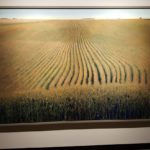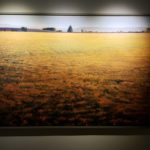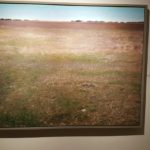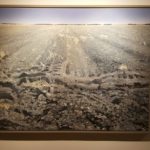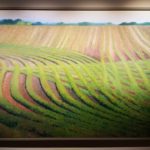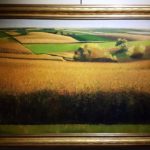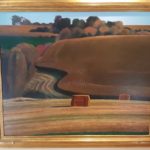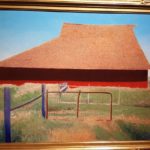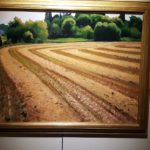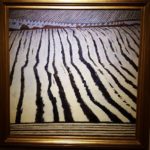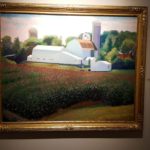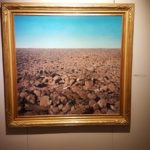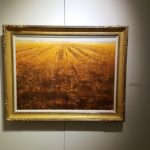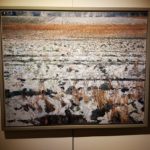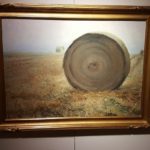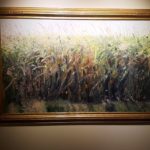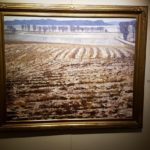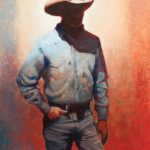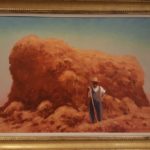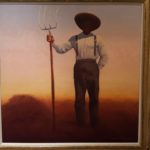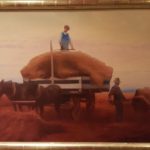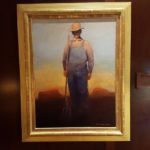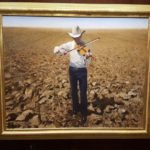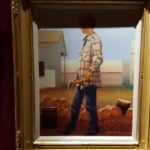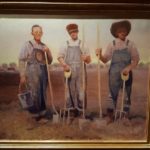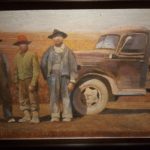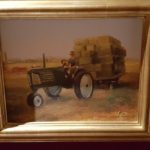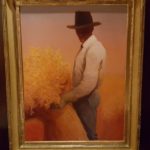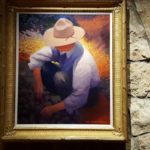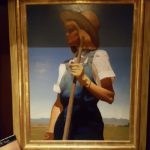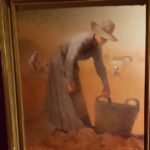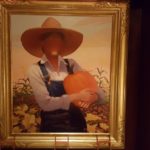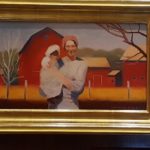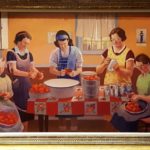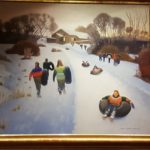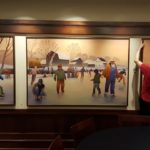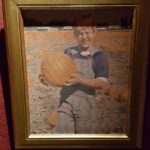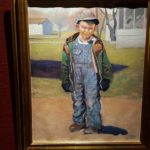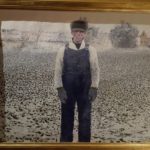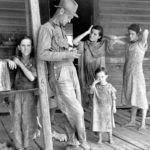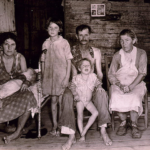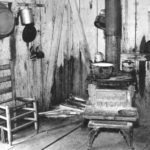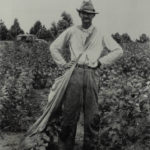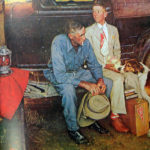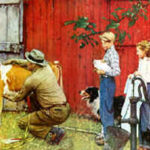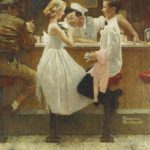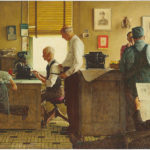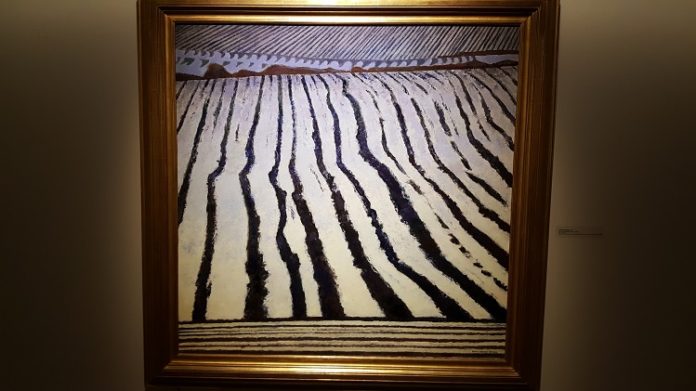
The four-month exhibition of paintings by Gary Ernest Smith that opened in August in downtown Perry and in Ames closes Jan. 6, so lovers of soothing and serene rural images from the last century have only a few more days to visit some 50 works filling temporary gallery space in the Hotel Pattee, the Security Bank Building and the Towncraft Center in Perry and the Brunnier Art Museum in the Scheman Building on the campus of Iowa State University.
The exhibition came about through a partnership between the Fullhart/Carnegie Charitable Trust doing business as Hometown Heritage and the Brunnier. The Perry venues hosted about 30 of Smith’s portraits, and the Ames museum featured about 20 landscapes painted by Smith.
Smith’s paintings originally made their way to Perry in the late 1990s through the taste and munificence of Roberta Green Ahmanson, who wished to decorate the restored Hotel Pattee with rural-themed art. At his September lecture in Perry, the artist Smith recalled first meeting Mrs. Green Ahmanson in a Scottsdale, Ariz., art gallery where he was hosting a one-man show.

“One day a very stately woman and her husband walked in the gallery and kind of milled around and looked at the paintings,” Smith said. “She introduced herself, but it really didn’t mean anything to me at the time. Well, she wound up buying eight paintings that day, and I said, ‘Wow!’ Since then, she’s acquired, gee, I don’t know, 60 or 70 paintings.”
Smith said Mrs. Green Ahmanson was not simply collecting sentimental images of rural nostalgia but was capturing the essence of the rural way of life itself, the culture of the white settlers and homesteaders who displaced the native populations, plowed up the tall grass prairie, turned the U.S. Midwest into the breadbasket of the world and still inhabit the land today. Smith said he was a kind of unwitting element in Mrs. Green Ahmanson’s vision.
“What she was doing,” Smith said, “she was collecting the heritage of the people of the Midwest. And even though I didn’t know that’s what I was doing at the time, I just knew there was something deep within me, that I grew up in rural America on a farm and lived that lifestyle for 18 years of my life. I thought there was nothing outside of farm work and ranch work except that I knew I was an artist, and that’s what I was going to be when I grew up and finally made the break. So I did. I left the lifestyle of the farm and became an artist and painted that lifestyle. I just couldn’t get it out of my system.”
This year’s double exhibition offered many art tours and programs in Perry and included the Odd Thursday Tours at the Hotel Pattee and other activities, featuring children’s classes, breakfast art talks, young professional and craft beer night, second-language tours and bike-and-art tours.
The final Odd Thursday Tour is scheduled for Dec. 29 from 4:30 p.m. to 6:30 p.m. at the Hotel Pattee, when winners of the Incentive Awards will be announced.
“Many of the planned events included an art cart,” said local artist Betsy Peterson of Perry, “with supplies for visitors who wanted to try their hand at making art inspired by the techniques of Gary Earnest Smith.”
Peterson is herself accomplished in the folk-art vernacular and was an enthusiastic supporter of the partnership between Hometown Heritage and the Brunnier Museum. She is also a big fan of Smith’s art and admires him as a colorist.
“There is something very modern about Smith’s palette,” Peterson said. “I love what he does with color.”
The Fullhart/Carnegie Charitable Trust owns most of the artworks in the hotel, and the exhibition of Smith’s portraits and the programming supporting it was made possible in part by a $2,000 grant from the Bock Family Foundation that Hometown Heritage landed in April. The local funds were used to buy supplies for the program and advertise the calendar of events.
The first public step in the partnership program came last August when Lynette Pohlman, chief curator and director of the University Museums at ISU, held a learning and discussion session about how to understand and connect with the artworks we see.
“Museum objects are transformed into teaching tools through intellectual and physical accessibility,” Pohlman said, and partnering with communities lying outside the university sphere, such as Perry, “has proved invaluable for demystifying the arts. By making the audience part of the creative process, they in turn become enthusiastic ambassadors for the value of the visual arts in an academic environment.”
Many of Smith’s paintings show farm laborers using methods from 75 or 100 years ago, giving contemporary viewers the nostalgic sense that this is how grandpa used to do it. The old ways are not quite lost to living memory, and so his images soothe viewers as old snapshots of the home place soothe. None of the controversial issues that sometimes plague modern food production disturb Smith’s gently comforting images, and for this most viewers seemed grateful, presumable including Mrs. Green Ahmanson.
In the mid-1990s, the artists Vitaly Komar and Alexander Melamid commissioned polls in 11 countries—including the United States, Russia, China, France, and Kenya—in order to discover scientifically what ordinary people want to see in a painting. With their statistical results in hand, Komar and Melamid then created “most wanted” and “least wanted” paintings that approximated the polling results.
For Americans, the poll showed people generally prefer, according to Komar and Melamid, “traditional styles over more modern designs. They also express a strong preference for paintings that depict landscapes or similar outdoor scenes. In addition, most Americans tend to favor artists known for a realistic style over those whose artworks are more abstract or modernistic.”
The following painting approximates the average American’s taste in painting, what Komar and Melamid called America’s “most wanted painting.”
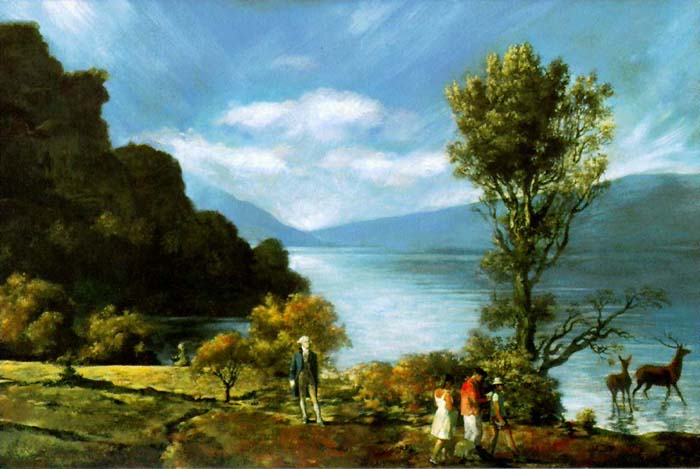
America’s most wanted painting — not altogether unlike a Smith work — is a realistic landscape peopled with a few figures, such as children and wildlife, and also including an historical personage, such as George Washington. This is what average Americans like in painting and if one thumbs through the paintings available for checkout at the Perry Public Library, one will find that most of the works approximate the most-wanted standard.
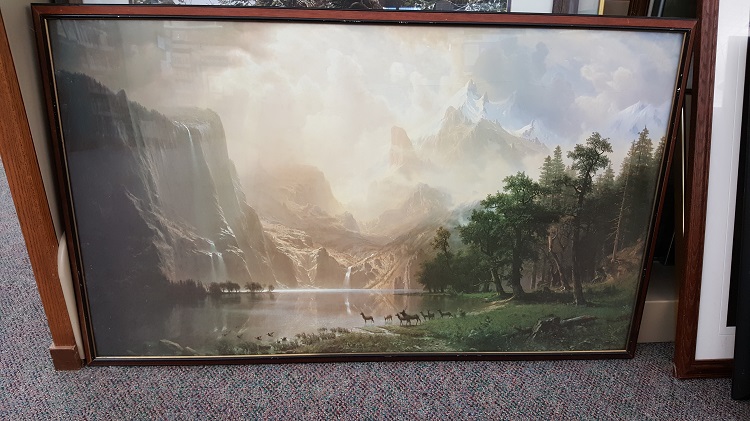
Smith was born in Baker, Ore., in 1942. He enrolled in Eastern Oregon College in 1963 and transferred to the Brigham Young University in 1964. His art studies were interrupted by military service, and he returned to BYU in 1970 to complete his degrees, earning a Bachelor of Fine Arts degree and a Master of Fine Arts degree.
According to his biography, Smith is an “integral member of the Mormon Art and Belief Movement” and a “neoregionalist painter and sculptor of the land and those who care for it.”
He lives in Highland, Utah, and draws on his boyhood memories of life on the farm for many of his themes.
“The demands of farm life taught me the values of discipline and self reliance,” Smith said. “When I left the farm for an art career, I was able to draw upon those deep seeded values that rural life had taught me, and my subject matter became those people, places and things that had been so ingrained in me while growing up on the farm. These images cross the boundaries of time and to me they are symbolic of the soul of America.”
The Brunnier exhibition was curated and organized by University Museums, with significant support from Roberta and Howard Ahmanson, Ray and Susan Johnson, Barb and Bill Clark, Denise and Jay Hartz of the Hotel Pattee and University Museums.
Additional support was also provided by Roger and Barbara Bruene, Michael A. Caufield, the city of Perry, the ISU College of Agriculture and Life Sciences, the Des Moines Convention and Visitors Bureau, Mark and Anne Honeyman, Al and Ann Jennings, Jan and Steve Kaiser, Gerald and Karen Kolschowsky, the Ladies of La Poste, Vicki and Jerry Lage, the Lions Club of Perry, the Perry Chamber of Commerce, the Perry Rotary Club, Betsy and Eric Peterson, the Raccoon Valley Banks, the Trustees of Hometown Heritage and the University Museums Membership.
The art in the Ames exhibition was lent from the collections of Howard and Roberta Ahmanson, Raymond and Susan Johnson of Minneapolis, Minn., and the Fullhart/Carnegie Charitable Trust doing business as Hometown Heritage.
![]()






